Abstract
One of the key parameters in the analysis of some motorcycle accident dynamics is the motorcycle’s deceleration during engine braking without applying the brakes. Since this issue lies far beyond what is usually of most interest—the critical states of movement—it is only sporadically addressed in the literature; however, these rare cases can be of fundamental importance. In our research, the results of engine-braking deceleration are presented for 26 motorcycles that were in gear with the throttle back. The tests were carried out at an initial speed of 140 km/h (if this was not possible, then from the maximum speed for a given gear) to the speed at which the motorcycle reached a constant speed or when engine operation became unstable. For all motorcycles and all gears, deceleration vs. speed and speed vs. time were plotted. Regression lines were determined, and their equations are provided, along with ±σ and ±2σ limit lines. Engine-braking deceleration was shown to be inversely proportional to both motorcycle speed (higher speed—lower deceleration) and gear number (higher gear—lower deceleration). Moreover, engine-braking deceleration at the top gear of the various motorcycles tested (i.e., 5th or 6th) was found to be close to each other. The data provided are of crucial importance from the motorcycle longitudinal dynamics and vehicle accident analysis standpoints.
1. Introduction
Motorcycles are becoming an increasingly common means of transport. This trend is vividly illustrated in Poland, where in the years 2013–2022, a 60% increase in the number of motorcycles was reported, and at present, there are over 1.8 million such vehicles registered [1]. The increasing popularity of motorcycles and their dynamics are notoriously reflected in road accident statistics. In the years 2017–2019, approximately 3500 motorcyclists died on European roads annually [2]. In most EU countries, the number of fatalities fell between 2019 and 2020. The COVID pandemic and the associated restrictions on mobility undoubtedly led to a reduction in the number of casualties [3]. However, motorcyclists’ deaths still account for around 16% of all road deaths on European roads [2].
The research on motorcycle longitudinal dynamics is generally focused on critical states, that is, extreme acceleration [4,5] and extreme braking, in both theoretical [6,7] and practical [8,9,10,11] approaches. In vehicle accident reconstruction, however, the motorcycle movement parameters below the critical states are equally important but less frequently examined. One of them is the deceleration of an engine-braked motorcycle—crucial in the case when the rider, having realized a potential collision, releases the twist grip throttle or when he/she falls off the motorcycle but the unmanned vehicle is running without a rider. An unbraked vehicle reduces its speed, owing to the braking torque generated by the engine (which operates as an air compressor), the resistance of the rotating masses of the powertrain, the rolling resistance, and the grade resistance. In [12], a method of calculating the drag torque of an engine was presented, which can be used to estimate the deceleration of a passenger car; however, the authors did not provide data relevant to a motorcycle engine. Moreover, in [13], it has been proved that the empirical values quoted in [12] do not fully represent the actual characteristics of the engine-braking torque of the tested car.
The issues related to engine braking are discussed in the literature, particularly in the context of commercial vehicles [14,15], because in these vehicles, the aspect of the wear of the elements on the braking system is of special significance. These matters have also been addressed in the context of accident reconstruction but with passenger cars [16,17].
The survey of the literature conducted by the authors before the research action resulted in the discovery of only a single publication on motorcycle engine braking [18]. From this source, it follows that at the top gears, motorcycle deceleration is in linear dependence on the speed and falls within the band bounded by equations amin = 0.0131v and amax = 0.0207v (a in [m/s2], v in [km/h]). These equations represent the test results for only five motorcycles (of unknown makes) with manual gearboxes and do not include low gears.
The importance of the title problem for the analysis of motorcycle accidents and data scarcity motivated the authors to research and develop dependences between engine-braked motorcycle deceleration, speed, and time.
2. Road Tests
The aim of the road tests was to measure the speed time histories of motorcycles when traveling in different gears after the twist grip throttle was fully released. In each test, a different gear was engaged. Each motorcycle was tested twice in each gear. All experiments were conducted in summer, in good weather conditions, on a flat and horizontal section of an asphalt surface. The Racelogic—VBox Sport data logger, which records speed and location versus time with a frequency of 20 Hz, was used. VBox Sport meets the requirements expected from instruments for the measurement of longitudinal vehicle dynamics parameters [19,20]. It was mounted on the motorcycles using a dedicated holder on the handlebar (Figure 1) or, if that was not possible, onto the fuel tank with a special adhesive tape.
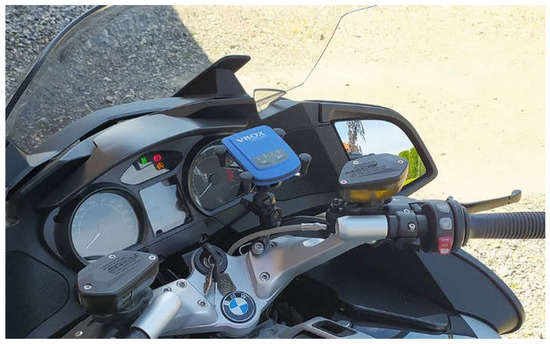
Figure 1.
VBox Sport mounted on the motorcycle.
In total, 26 motorcycles with engine capacities ranging from 125 cm3 to 1800 cm3 were tested. In Table A1, Appendix A, their data are specified, including the year of manufacture, catalog mass, engine type, capacity, engine maximum power (taken from the registration certificates), and mileage (read from the odometers). As the mechanics of drivetrains and combustion engines themselves have not changed in a revolutionary way over the years, we expected newer motorcycles to achieve similar engine decelerations. Moreover, 1985–2017 motorcycles are still in use, so the results are still applicable. All the test motorcycles were in good technical condition and loaded only with the mass of a rider wearing motorcycle clothing, i.e., approximately 95 kg. To reduce the number of factors affecting the results, all the motorcycles were tested by the same rider.
The study of the impact of the motorcyclist’s mass (in the range of 95 ± 20 kg) on the kinematic parameters of an engine-braked motorcycle was abandoned, because the preliminary simulation tests showed that it can be ignored.
In each test, the motorcycle was brought up to a speed of slightly over 140 km/h or the maximum speed in a specific gear. Next, reducing the speed after the twist grip throttle was released, the motorcycle traveled freely until either a steady speed was reached or the engine operation (and usually also the movement of the motorcycle) became unstable.
3. Data Processing
Using the VBox Sport measurement device, all the tests for each motorcycle were recorded in one file. Next, in the VBox Test Suite software, individual tests were identified. The VBox Sport records, inter alia, vehicle speed and location vs. time, but it does not record the distance directly. This parameter was easily calculated using the VBox Test Suite software. The files with the data (speed, time, and distance) from each test were exported and processed in a spreadsheet.
- Dependences of speed on distance for each motorcycle and each gear (an example is shown in Figure 2) enabled the nearly linear sections to be identified.
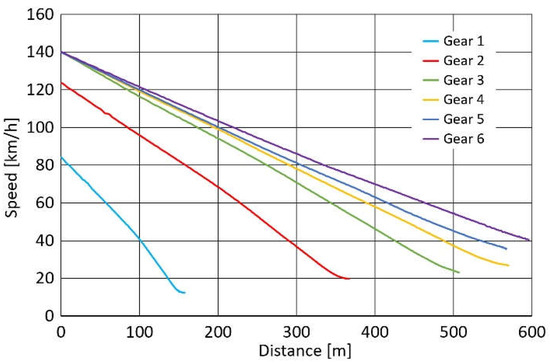 Figure 2. Speed vs. distance for the Honda XL1000 V.
Figure 2. Speed vs. distance for the Honda XL1000 V. - For these speed ranges, deceleration vs. speed was plotted (an example is shown in Figure 3). Having a set of deceleration measurements of several motorcycles braked on the 2nd gear, we averaged them using the formula , where is the number of motorcycles performing the test, and i is the index of the measurement sample. This relationship—represented by a blue sawtooth graph—was approximated by a linear function plotted in red.
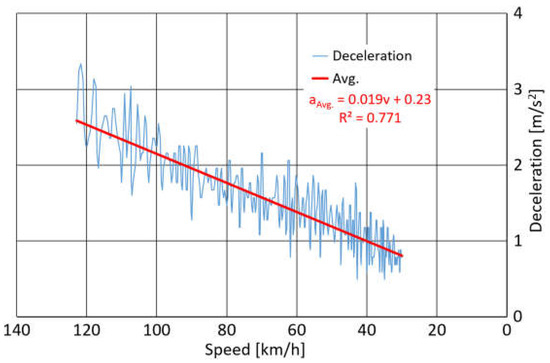 Figure 3. Deceleration vs. speed for the Honda XL1000 V traveling in 2nd gear.
Figure 3. Deceleration vs. speed for the Honda XL1000 V traveling in 2nd gear. - Deceleration vs. speed can be approximated with linear functions, which are listed in the section Statistical Analysis. The linear approximation was found to sufficiently well represent the character of distance-dependent deceleration.
- For each tested motorcycle, the deceleration vs. speed in particular gears was plotted (an example is shown in Figure 4).
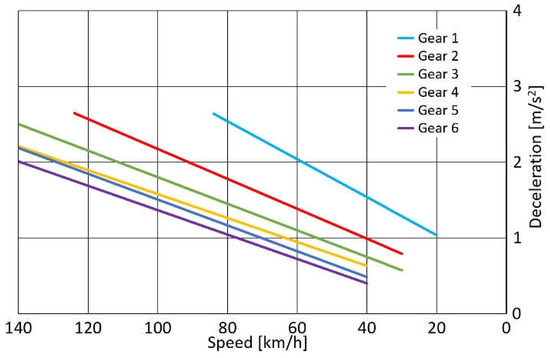 Figure 4. Average deceleration vs. speed for all gears of the Honda XL1000 V.
Figure 4. Average deceleration vs. speed for all gears of the Honda XL1000 V.
Finally, the most useful in the analysis of motorcycle accident dynamics representation of the results, which are the speed-dependent decelerations separately for each gear, are shown in Appendix A.
4. Statistical Analysis
In order to keep the main message of the article concise, the source graphs of deceleration vs. speed were collected in Appendix A as Figure A1, Figure A2, Figure A3, Figure A4, Figure A5, Figure A6 and Figure A7 and supplemented with the results of the statistical analysis.
The deceleration vs. speed data were processed statistically. Since the sample size was modest (n = 26), the Shapiro–Wilk test was employed to prove that the distribution of the variables was compatible with normal distribution (p > 0.05).
For each set of results for individual gears, the mean values and standard deviations were calculated. In the plots included in Appendix A, regression lines are marked, and their equations are given. Also, the boundary lines ±1σ and ±2σ, which restrict the set of results to circa 68% and 95% of observations, respectively, are marked. The equations describing the mean speed-dependent decelerations of engine-braked motorcycles in particular gears (where v is given in [km/h] and in [m/s2]) read:
As the decelerations in the top gears (5th or 6th) did not differ significantly (cf. Equations (5) and (6), they are also plotted together in Figure A7, and the approximation is expressed as:
To facilitate a comparison of Equations (1)–(6), in Figure 5 for all tested motorcycles, the average deceleration vs. speed in particular gears is plotted.
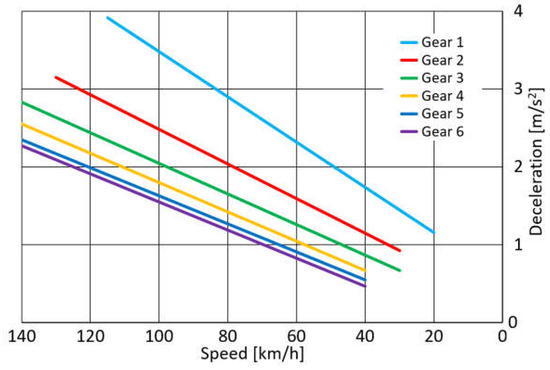
In programs for the simulation of vehicle dynamics, it is more convenient to use time-dependent parameters. Therefore, Figure A8, Figure A9, Figure A10, Figure A11, Figure A12, Figure A13 and Figure A14 in Appendix A show the average speed of motorcycles as a function of time, which are graphical representations of the formulae:
To convert these dependences to acceleration or distance, it is enough to differentiate or integrate them over time, respectively.
5. Discussion
The test results indicate that an engine-braked motorcycle’s deceleration is determined first of all by the motorcycle’s speed and the gear engaged. The lower the motorcycle speed, the lower the deceleration. From the plots presented in Appendix A, it follows that the deceleration at an initial speed of 100 km/h is most frequently twice higher than at a speed of 50 km/h. For the same speed, higher decelerations occur at lower gears, which results from the large total transmission ratio.
The plot concerning the top gears, that is, 5th or 6th (Appendix A, Figure A7), indicates that in these cases the deceleration decreases linearly from 2.2 ± 0.5 m/s2 at 140 km/h to 0.5 ± 0.2 m/s2 at 40 km/h.
The type of engine does not significantly affect deceleration, although the motorcycles with in-line engines (purple plots in Figure A1, Figure A2, Figure A3, Figure A4, Figure A5, Figure A6 and Figure A7) tended to reach slightly higher decelerations than those with V-type engines (blue plots). This might result from the fact that the in-line engine pistons have larger diameters and shorter strokes than the V-type engines, and, consequently, their design is closer to that of reciprocating compressors.
No dependence between engine capacity or power and deceleration was recorded. The influence of manufacturers and models on deceleration was also not noticed. The motorcycles slowed down by engine braking without using the brakes, so neither the design of the braking system nor the anti-lock braking system (ABS) was relevant in the research performed.
The manufacturers’ race boils down primarily to improving the electronics and design of new motorcycle models, while the mechanical parameters of combustion engines and drivetrains themselves (determining, among others, engine-braking performance) are more conservative. Therefore, the conclusions of our research are generally valid, although they are not directly based on tests of the most recent motorcycle models.
6. Conclusions
- The test results presented in this article are of considerable significance for the analysis of motorcycle longitudinal dynamics and accident analysis, because they make it possible to calculate different kinematic parameters of an engine-braked motorcycle.
- The deceleration of an engine-braked motorcycle depends on the vehicle’s speed. Therefore, one constant value of deceleration should not be adopted in the calculation; on the contrary, graphs or formulae should be referred to.
- The deceleration of an engine-braked motorcycle depends also on the gear engaged. Consequently, in the post-accident examination of a motorcycle, it is very important to establish which gear was engaged during the accident [21].
- No dependence between the swept volume or engine power and deceleration was found. Motorcycles with in-line engines tend to reach slightly higher decelerations than those with V-type engines.
Author Contributions
Conceptualization, P.C.; methodology, P.C.; statistical analysis, P.C.; consultation on statistical analysis, J.Z.; writing—original draft preparation, P.C.; writing—review and editing, P.C. and W.W. All authors have read and agreed to the published version of the manuscript.
Funding
This research received no external funding.
Institutional Review Board Statement
Not applicable.
Informed Consent Statement
Not applicable.
Data Availability Statement
Not applicable.
Acknowledgments
This work was supported by the Institute of Forensic Research in Krakow—Project No. III/W/2018.
Conflicts of Interest
The authors declare no conflict of interest.
Appendix A

Table A1.
Data of motorcycles used in tests.
Table A1.
Data of motorcycles used in tests.
| Make | Model | Model Year | Odometer [km] | Engine Type | Capacity [cm3] | Power [kW] | Mass [kg] |
|---|---|---|---|---|---|---|---|
| BMW | K1600GT | 2015 | 31,810 | R6 | 1649 | 118.0 | 332 |
| K1200R | 2007 | 38,621 | R4 | 1157 | 120.0 | 307 | |
| R1200C | 2002 | 7950 | B2 | 1170 | 45.0 | 229 | |
| R1200RT | 2006 | 73,500 | B2 | 1170 | 81.0 | 259 | |
| R1200GS | 2017 | 18,545 | B2 | 1170 | 92.0 | 244 | |
| R1200GS Adv. | 2014 | 48,074 | B2 | 1170 | 92.0 | 260 | |
| F650GS | 2000 | 54,136 | 1 | 652 | 37.0 | 193 | |
| Honda | CBR 950RR | 2002 | 9179 | R4 | 954 | 110.0 | 194 |
| CBF600 | 2005 | 57,355 | R4 | 600 | 57.0 | 217 | |
| CRF1000A | 2016 | 24,124 | R2 | 998 | 70.0 | 220 | |
| VFR800 | 2002 | 48,225 | V4 | 782 | 80.0 | 244 | |
| VTX1300 | 2004 | 35,983 | V2 | 1312 | 55.0 | 320 | |
| XL1000V | 2000 | 55,123 | V2 | 996 | 69.0 | 250 | |
| VT700C | 1985 | 66,264 | V2 | 694 | 46.0 | 227 | |
| Kawasaki | XZ9R | 1999 | 28,624 | R4 | 899 | 72.0 | 207 |
| Suzuki | GSX1400 | 2002 | 54,327 | R4 | 1402 | 78.0 | 256 |
| GSR600 | 2011 | 29,573 | R4 | 599 | 72.0 | 213 | |
| GS500E | 1998 | 42,076 | R2 | 487 | 25.0 | 188 | |
| VLR1800 | 2008 | 51,556 | V2 | 1783 | 94.0 | 380 | |
| S83 | 2005 | 28,695 | V2 | 1360 | 53.0 | 243 | |
| VS800 | 2000 | 97,560 | V2 | 805 | 38.7 | 212 | |
| DL650 | 2005 | 75,526 | V2 | 645 | 49.0 | 220 | |
| VL125 | 2002 | 12,918 | V2 | 124 | 9.8 | 190 | |
| Yamaha | XJ6 | 2011 | 24,730 | R4 | 600 | 57.0 | 200 |
| MT-09 Trecer | 2015 | 23,887 | R3 | 847 | 85.0 | 210 | |
| Zipp | VZ-1 | 2015 | 3674 | 1 | 125 | 8.7 | 110 |
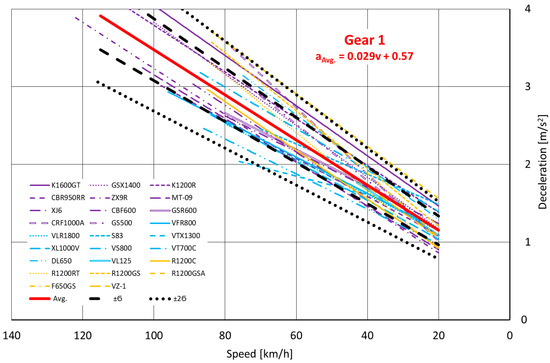
Figure A1.
Decelerations of engine-braked motorcycles in 1st gear.
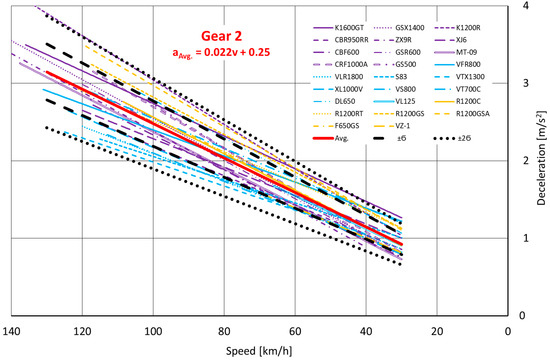
Figure A2.
Decelerations of engine-braked motorcycles in 2nd gear.
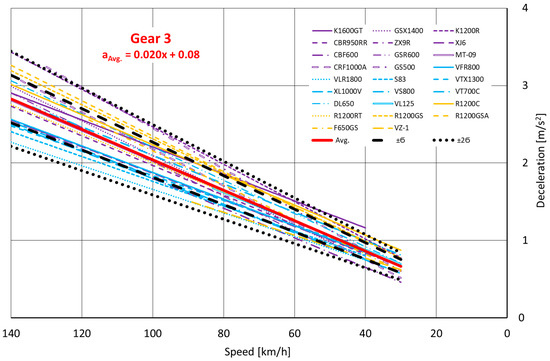
Figure A3.
Decelerations of engine-braked motorcycles in 3rd gear.
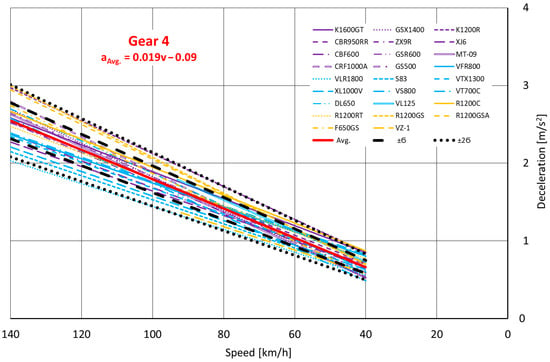
Figure A4.
Decelerations of engine-braked motorcycles in 4th gear.
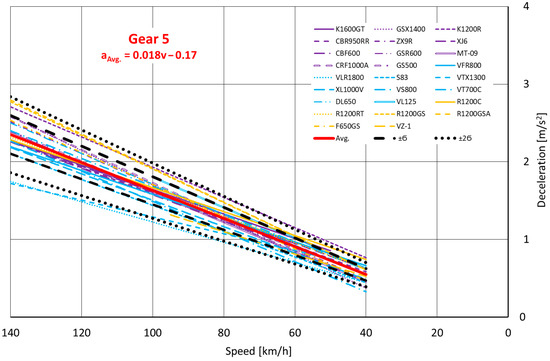
Figure A5.
Decelerations of engine-braked motorcycles in 5th gear.
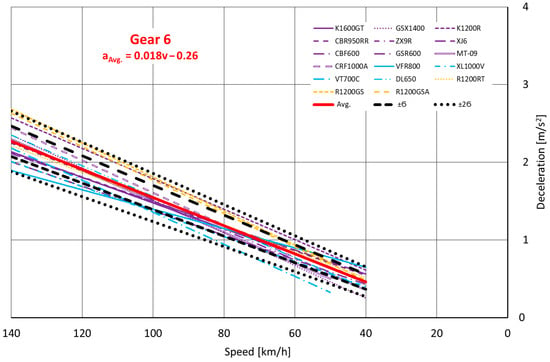
Figure A6.
Decelerations of engine-braked motorcycles in 6th gear.
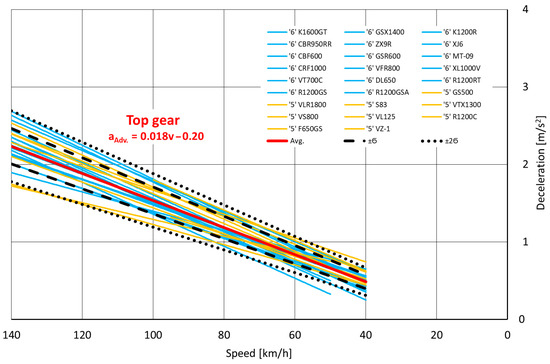
Figure A7.
Decelerations of engine-braked motorcycles in top gears (5th or 6th).
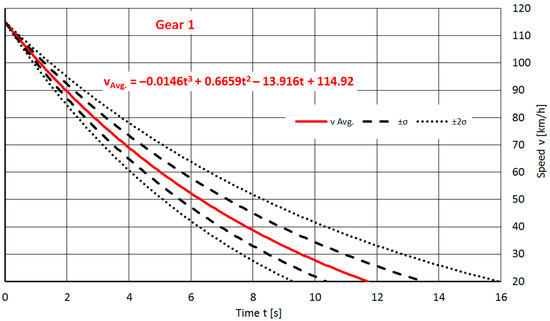
Figure A8.
Speed of engine-braked motorcycles vs. time in 1st gear.
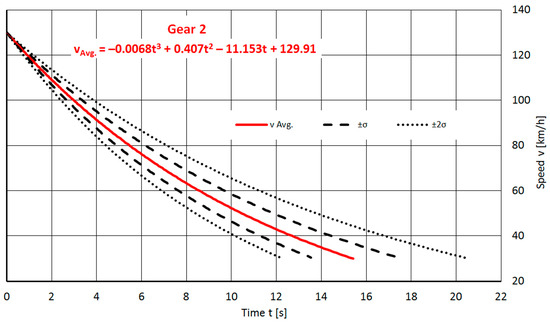
Figure A9.
Speed of engine-braked motorcycles vs. time in 2nd gear.
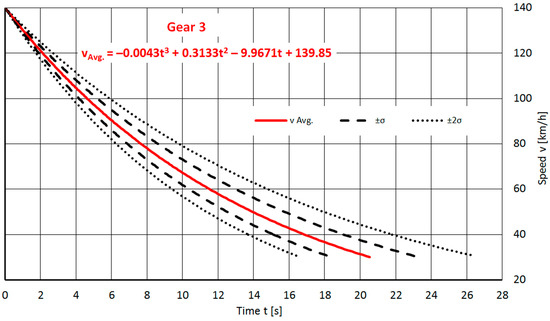
Figure A10.
Speed of engine-braked motorcycles vs. time in 3rd gear.
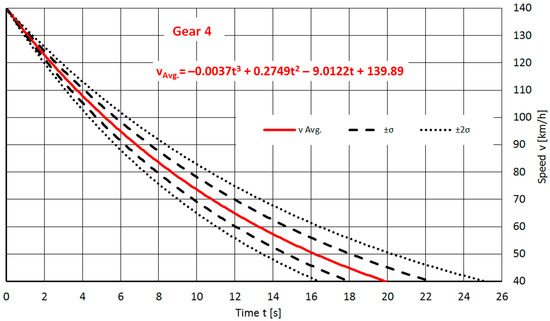
Figure A11.
Speed of engine-braked motorcycles vs. time in 4th gear.
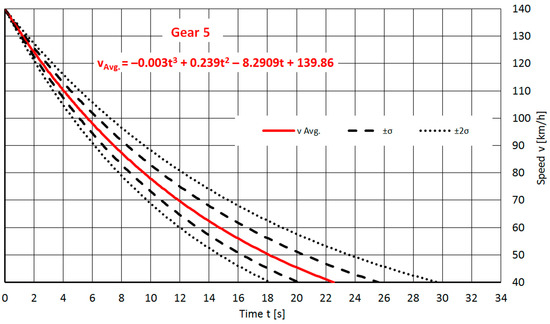
Figure A12.
Speed of engine-braked motorcycles vs. time in 5th gear.
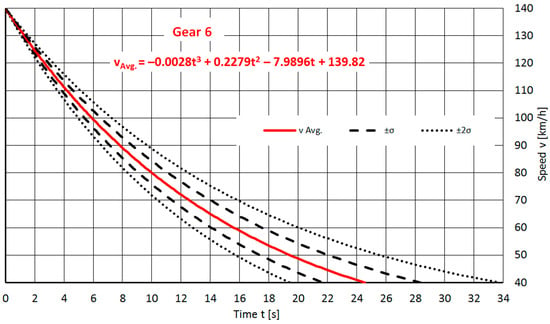
Figure A13.
Speed of engine-braked motorcycles vs. time in 6th gear.
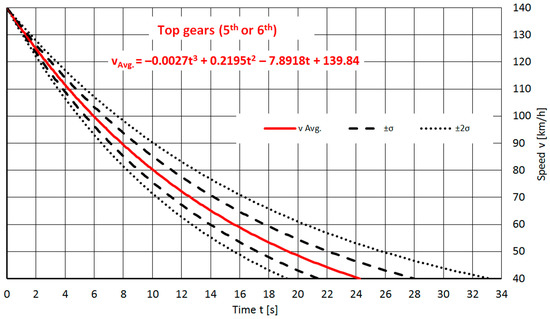
Figure A14.
Speed of engine-braked motorcycles vs. time in top gears (5th or 6th).
References
- Wypadki Drogowe w Polsce w 2022 roku. Biuro Ruchu Drogowego Komendy Głównej Policji. (Road Accidents in Poland in 2022, Road Traffic Office of the General Police Headquarters). Available online: https://statystyka.policja.pl/download/20/403374/Wypadkidrogowe2022.pdf (accessed on 25 May 2023). (In Polish).
- Facts and Figures—Motorcyclists and Moped Riders—2023. European Road Safety Observatory. Available online: https://road-safety.transport.ec.europa.eu/document/download/0d6f5d7c-c253-42fa-925e-999666ca82ac_en?filename=ff_p2w_bis_20230213.pdf (accessed on 25 May 2023).
- National Road Safety Profile—Poland, European Road Safety Observatory. Available online: https://road-safety.transport.ec.europa.eu/document/download/2c13d888-e754-488f-8557-9542a917c30b_en?filename=erso-country-overview-2023-poland_0.pdf (accessed on 25 May 2023).
- Bartlett, W. Estimating maximum motorcycle acceleration rates. Collis. Mag. 2011, 6, 1934–8681. [Google Scholar]
- Lewandowski, A.; Kędziora, K.; Waluś, K.J.; Dudziak, M. Measurements of Motorcycle Accelerations. In Proceedings of the 16th Annual Congress of the European Association for Accident Research and Analysis (EVU), Kraków, Poland, 8–10 November 2007. [Google Scholar]
- Cossalter, V.; Lot, R.; Maggio, F. On the Braking Behavior of Motorcycles; SAE Technical Paper 2004-32-0018; SAE International: Pittsburgh, PA, USA, 2004. [Google Scholar] [CrossRef]
- Corno, M.; Savaresi, S.M.; Tanelli, M.; Fabbri, L. On optimal motorcycle braking. Control Eng. Pract. 2008, 16, 644–657. [Google Scholar] [CrossRef]
- Ecker, H.; Wassermann, J.; Hauer, G.; Ruspekhofer, R.; Grill, M. Braking Deceleration of Motorcycle Riders. In Proceedings of the International Motorcycle Safety Conference, Orlando, FL, USA, 1–4 March 2001. [Google Scholar]
- Frank, T.; Smith, J.; Hansen, D.; Werner, S. Motorcycle rider trajectory in pitch-over brake applications and impacts. SAE Int. J. Passeng. Cars—Mech. Syst. 2009, 1, 31–42. [Google Scholar] [CrossRef]
- Fatzinger, E.; Landerville, J.; Bonsall, J.; Simacek, D. An Analysis of Sport Bike Motorcycle Dynamics during Front Wheel Over-Braking; SAE Technical Paper 2019-01-0426; SAE International: Pittsburgh, PA, USA, 2019. [Google Scholar] [CrossRef]
- Hugemann, W.; Lange, F. Braking performance of motorcyclists. Impact 2001, 10, 16–22. [Google Scholar]
- Wach, W.; Świder, P. Mechanika ruchu samochodu (Mechanics of vehicle movement). In Wypadki drogowe. Vademecum biegłego sądowego (Vehicle Accidents. Vademecum of an Expert Witness), 2nd ed.; Wierciński, J., Reza, A., Eds.; Instytut Ekspertyz Sądowych (Institute of Forensic Research): Kraków, Poland, 2011; pp. 265–360. (In Polish) [Google Scholar]
- Świder, P.; Wach, K.; Wolak, S. Porównanie charakterystyk momentu hamującego silnika, określonych na podstawie badań drogowych, z zależnością empiryczną podawaną w literaturze (Engine braking torque characteristics determined in road tests compared with the empirical formula presented in the literature). Paragraf na Drodze 2012, 6, 58–68. (In Polish) [Google Scholar]
- Saggam, N.; Edke, P.; Alagarsamy, G.; Kohli, S.; Vance, M. Engine Braking: A Perspective in Terms of Brake Power; SAE Technical Paper 2019-26-0288; SAE International: Pittsburgh, PA, USA, 2019. [Google Scholar] [CrossRef]
- Bartlett, W. Engine braking. Accid. Reconstr. J. 2019, 29, 19–20. [Google Scholar]
- Eberhardt, W.; Himbert, G. Beschleunigungsverhalten von Kraftfahrzeugen. Verkehrsunfall und Fahrzeugtechnik 1993, 9, 257–261. (In German) [Google Scholar]
- Ślaski, G.; Walkowiak, J. Hamowanie silnikiem samochodu wyposażonego w automatyczną skrzynię biegów (Vehicle with automatic transmission decelarting with engine braking torque). Logistyka 2009, 6, 256–265. (In Polish) [Google Scholar]
- Toda, H.; Ogura, T.; Ito, T.; Isowa, K.; Ueji, K.; Oga, R.; Okuno, K. Application of motorcycle engine brake performance to traffic accident reconstruction. Jpn. J. Forensic Sci. Tech. 2017, 22, 35–42. [Google Scholar] [CrossRef][Green Version]
- Ciępka, P.; Janczur, R. Urządzenie VBox Sport w praktyce biegłego i rzeczoznawcy samochodowego (VBox Sport in the practice of a court expert witness and certified motor vehicle expert). Paragraf na Drodze 2019, 4, 63–73. [Google Scholar]
- VBox Sport. Available online: https://www.vboxmotorsport.co.uk/downloads/datasheets/VBOX%20Sport%20-Datasheet.pdf (accessed on 31 October 2017).
- Kubly, K.; Buse, C. Motorcycle Post-Accident Inspection Techniques; SAE Technical Paper 850064; SAE International: Pittsburgh, PA, USA, 1985. [Google Scholar] [CrossRef]
Disclaimer/Publisher’s Note: The statements, opinions and data contained in all publications are solely those of the individual author(s) and contributor(s) and not of MDPI and/or the editor(s). MDPI and/or the editor(s) disclaim responsibility for any injury to people or property resulting from any ideas, methods, instructions or products referred to in the content. |
© 2023 by the authors. Licensee MDPI, Basel, Switzerland. This article is an open access article distributed under the terms and conditions of the Creative Commons Attribution (CC BY) license (https://creativecommons.org/licenses/by/4.0/).